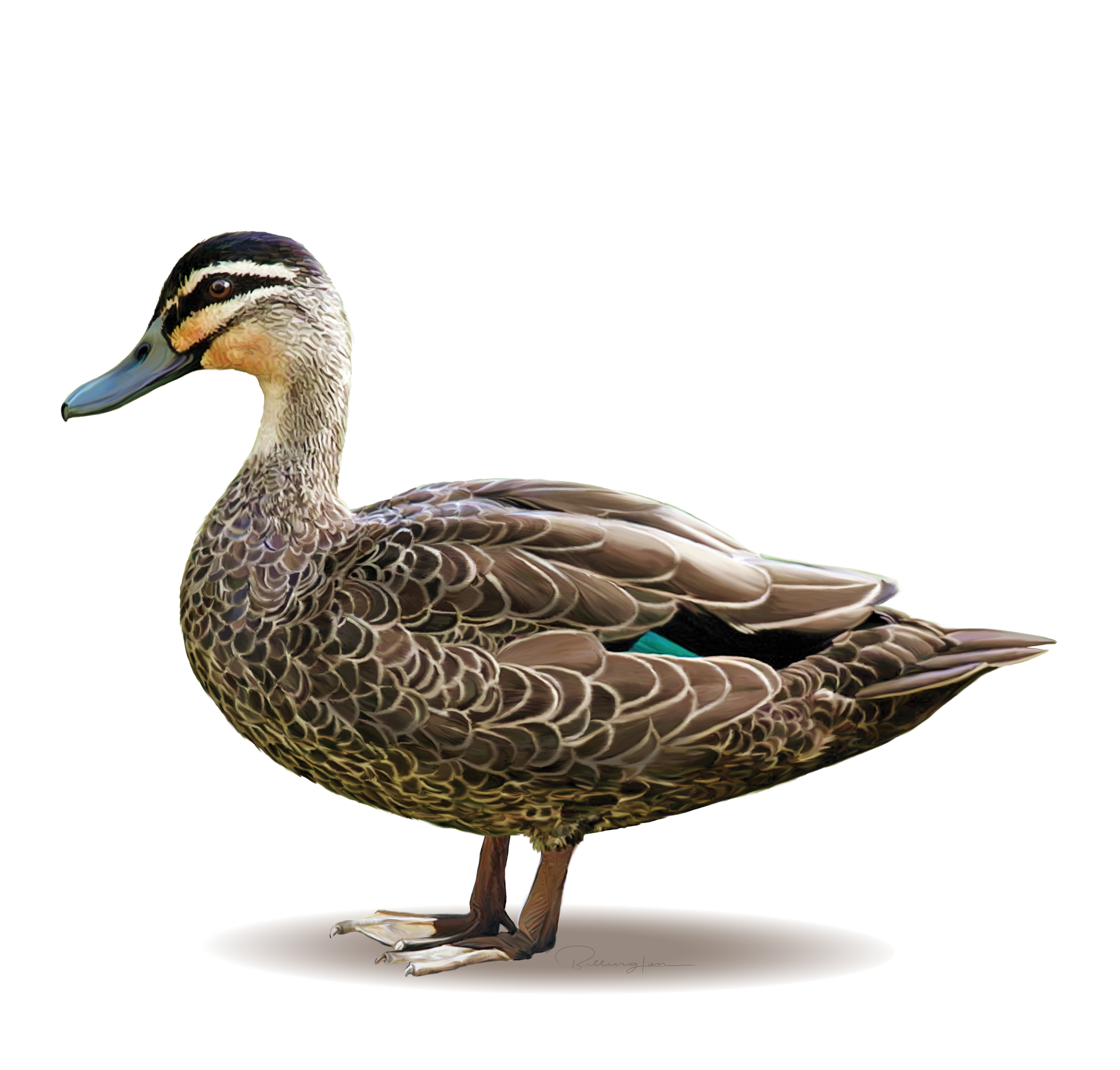Game duck species
In normal years, eight species of native duck may be hunted in Victoria. These species are listed below.
(Photo by Reg Gordon)
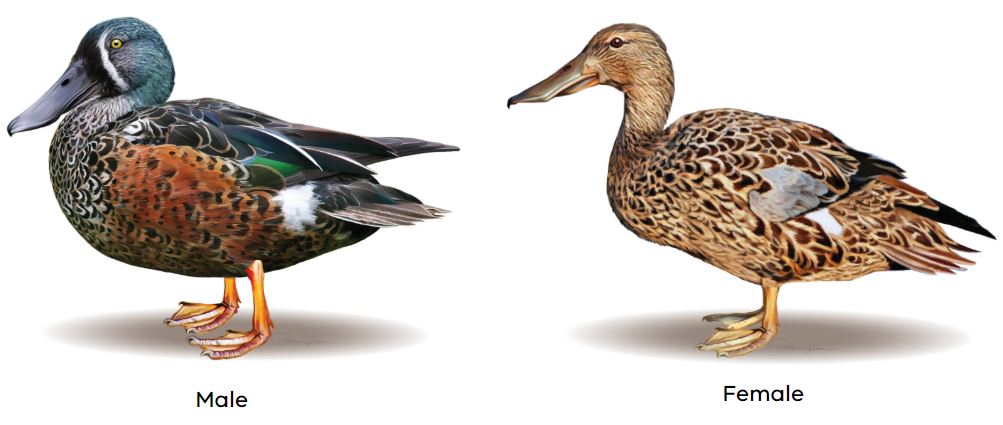 Appearance
Appearance
*Important: the Blue-winged Shoveler can no longer be hunted during duck season due to it being listed as threatened under the Flora and Fauna Guarantee Act 1988*
The Blue-winged Shoveler is a distinctive species with a slender build and a broad, blue-grey bill. The male is more colourful than the female and has a blue-grey head and neck, white face crescent, black back, a white patch on the rump and a deep chestnut-coloured belly. The colouring of the male fades when not in breeding condition. The male has bright yellow to orange legs and feet and is the only native duck to do so. The female is predominantly brown with a light chestnut-coloured belly.
Habitat and distribution
The Blue-winged Shoveler can be found in all eastern states of Australia as well as from the south up to the north-west cape of Western Australia. In eastern Australia, it can be found from as far south as Tasmania to Cairns in the north. The species prefers permanent, well-vegetated wetlands with areas of open water. Habitat may be freshwater or saline. Usually an uncommon duck, the Blue-winged Shoveler is distributed throughout south-eastern and south-western Australia, preferring inland cumbungi swamps and coastal tea-tree swamps. Blue-winged Shovelers are seldom heard but do have a soft chatter when flying.
For more detailed information and video click https://www.youtube.com/watch?v=Lz5otYO1Yc0
Distribution
The Blue-winged Shoveler prefers permanent, well-vegetated wetlands with areas of open water. Habitat may be freshwater or saline. Usually an uncommon duck, the Blue-winged Shoveler is distributed throughout south-eastern and south-western Australia, preferring inland cumbungi swamps and coastal tea-tree swamps.
Status
The Blue-winged Shoveler is a game species however it is no longer available for recreational hunting in Victoria.
Description
The Blue-winged Shoveler is a distinctive species with a slender build and a broad, blue-grey bill. The male is more colourful than the female and has a blue-grey head and neck, white face crescent, black back, a white patch on the rump and a deep chestnut-coloured belly. The colouring of the male fades when not in breeding condition. The male has bright yellow to orange legs and feet and is the only native duck to do so. The female is predominantly brown with a light chestnut-coloured belly.
In flight, the Blue-winged Shoveler has very quick wing beats with a distinctive whirr, white underwings, large pale patches on upperwing and the male has bright orange legs. In flight, the Blue-winged Shoveler appears much darker than other waterfowl and the wedge-shaped head is obvious.
On the water, the Blue-winged Shoveler is a medium-sized duck which floats low, has a distinctive wedge-shaped head and the male has a white patch on its rump
Voice
Blue-winged Shovelers are seldom heard but do have a soft chatter when flying.
Images
Here are some images of the Blue-winged Shoveler.
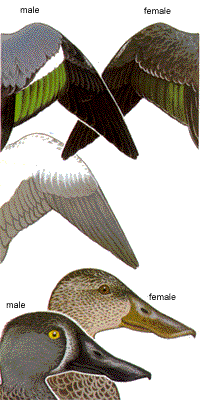
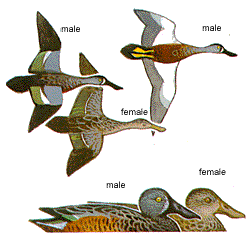
Video footage
Video footage of the Blue-winged Shoveler can be found here: Blue-winged Shoveler (Australasian Shoveler)
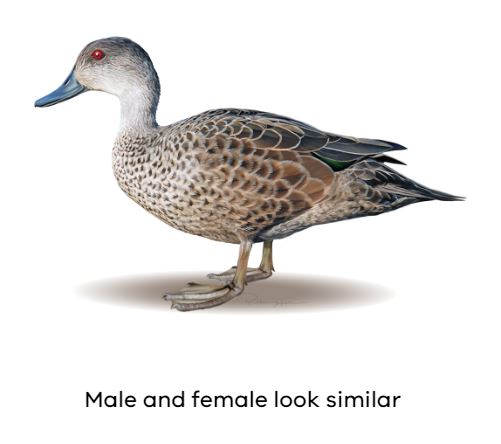 Appearance
Appearance
The Grey Teal is a mottled brown bird which frequently mixes with other species. The Grey Teal is lighter in colour than the Chestnut Teal, particularly around the head and neck. The male and female have a similar appearance.
On the water, the Grey Teal is a small duck which floats high. Its general colour above is a dark grey-brown with a pale almost white face and throat. The Grey Teal has no eye stripe.
In flight, the Grey Teal has a wedge-shaped white patch on both the upperwing and underwing. It has a shorter and thicker neck than the Black Duck.
Habitat and distribution
A major game species, the Grey Teal is common and widely distributed throughout Australia. Grey Teal can be found across a range of habitat types, from mangrove estuaries of the coast to deep, cold lakes of the highlands. It is found in its greatest numbers in the tree-lined billabongs, lagoons and floodwaters of the Murray-Darling River system. The species is highly nomadic and will move in response to local conditions.
The female has a loud penetrating "laughing" quack repeated rapidly fifteen or more times.
For more detailed information and video click: https://www.youtube.com/watch?v=MY5hCfYxpTA
Distribution and habitat

A major game species, the Grey Teal is common and widely distributed throughout Australia. Grey Teal can be found across a range of habitat types, from mangrove estuaries of the coast to deep cold lakes of the highlands. It is found in its greatest numbers in the tree-lined billabongs, lagoons and floodwaters of the Murray-Darling River system. The species is highly nomadic and will move in response to local conditions.
Status
The Grey Teal is available for recreational hunting in Victoria, South Australia, Tasmania, Queensland and the Northern Territory.
Description
The Grey Teal is a mottled brown bird which frequently mixes with other species. The Grey Teal is lighter in colour than the Chestnut Teal, particularly around the head and neck. The male and female have a similar appearance.
In flight, the Grey Teal has a wedge-shaped white patch on both the upperwing and underwing. It has a shorter and thicker neck than the Black Duck.
On the water, the Grey Teal is a small duck which floats high. Its general colour above is a dark grey-brown with a large, pale almost white face and throat. The Grey Teal has no eye stripe.
Voice
The female has a loud penetrating "laughing" quack repeated rapidly fifteen or more times.
Images
Here are some images of the Grey Teal.
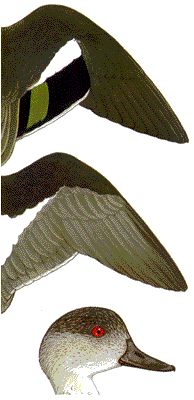
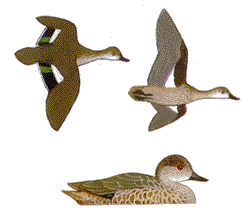
Video footage
Video footage of the Grey Teal can be seen here: Grey Teal
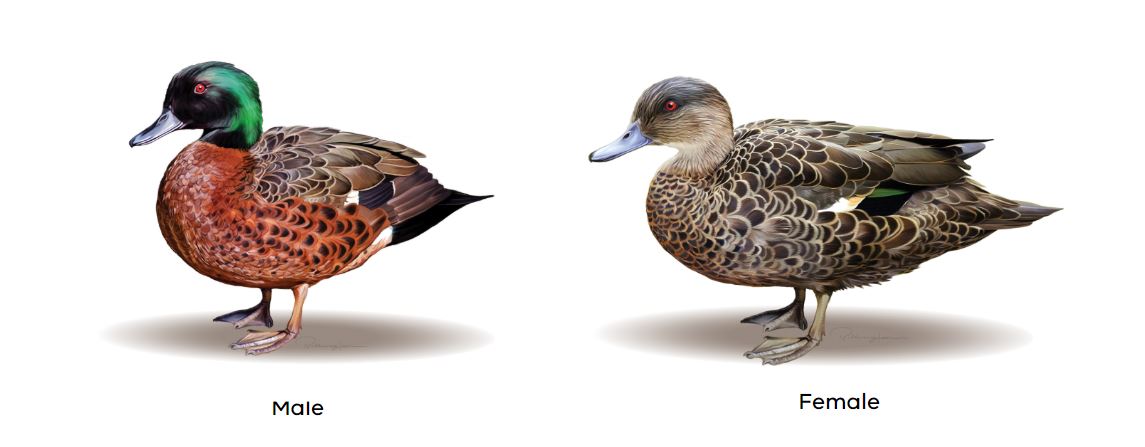
The Chestnut Teal is darker and a slightly bigger bird than the Grey Teal. In flight, the wedge-shaped white patch on both the upperwing and underwing is obvious. The male Chestnut Teal has a white patch on the flank which can also be seen in flight. The male is a dark bird with a very dark glossy-green head.Appearance
On the water, the Chestnut Teal is a small, dark duck which floats high. The male has a glossy-green head and a white flank patch. The female and juvenile male are similar to the drab Grey Teal, but are darker and lack the white throat.
Habitat and distribution
Most common in brackish coastal lagoons, saltwater estuaries and the lower reaches of creeks around the coast, the Chestnut Teal is distributed in south-eastern and south-western Australia. Vagrants may occur elsewhere. Tasmania and southern Victoria are the species' stronghold.
For more detailed information and video click: https://www.youtube.com/watch?v=CA1Lb2C9SF0
Distribution and habitat

Most common in brackish coastal lagoons, saltwater estuaries and the lower reaches of creeks around the coast, the Chestnut Teal is distributed in south-eastern and south-western Australia. Vagrants may occur elsewhere. Tasmania and southern Victoria are the species' stronghold.
Status
The Chestnut Teal is available for recreational hunting in Victoria, South Australia and Tasmania.
Description
The Chestnut Teal is darker and a slightly bigger bird than the Grey Teal. In flight, the wedge-shaped white patch on both the upperwing and underwing is obvious. The male Chestnut Teal has a white patch on the flank which can also be seen in flight. The male is a dark bird with a very dark head.
On the water, the Chestnut Teal is a small, dark duck which floats high. The male has a glossy green head and a white flank patch. The female and juvenile male are similar to Grey Teal, but are darker and lack the white throat.
Voice
The female Chestnut Teal has a loud penetrating "laughing" quack repeated rapidly nine times or more.
Images
Here are some images of the Chestnut Teal.
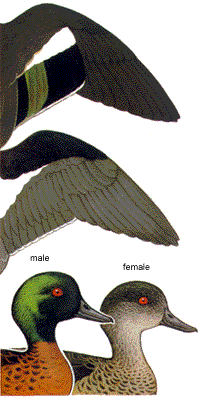
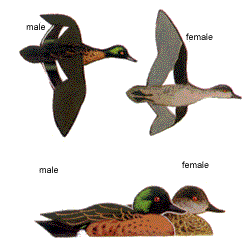
Video footage
Video footage of the Chestnut Teal can be found here: Chestnut Teal
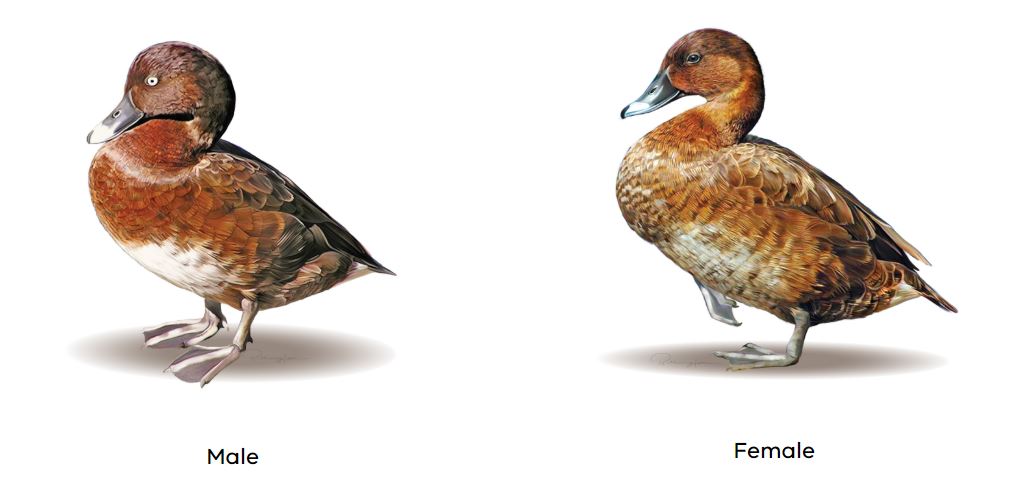 Appearance
Appearance
A medium-sized, dark-brown bird with white feathers under the tail. The male has a white eye.
In flight, the Hardhead has a large white band across the belly, the underwing is translucent white and the upperwing has a white strip on the trailing edge. The Hardhead is very swift in flight with rapid, short wing beats. The wings are narrow and pointed and set well back on the body.
On the water, the Hardhead is a dark coloured duck, floating very low and sometimes the white undertail is visible.
Habitat and distribution
The Hardhead is widely distributed throughout Australia, however, the stronghold of the species is in the deeper, permanent freshwater swamps and lagoons of the Murray-Darling Basin and south-east South Australia. They are also common in south-west Western Australia.
For more detailed information and video click: https://www.youtube.com/watch?v=p8w9FiBT6Tk
Distribution and habitat

The Hardhead is widely distributed throughout Australia, however, the stronghold of the species is in the deeper, permanent freshwater swamps and lagoons of the Murray-Darling Basin and south-east South Australia. They are also common in south-west Western Australia.
Status
The Hardhead is available for recreational hunting in Victoria, South Australia, Queensland and the Northern Territory.
Description
A medium-sized, dark-brown bird with white feathers under the tail. The male has a white eye.
In flight, the Hardhead has a large white band across the belly, the underwing is translucent white and the upperwing has a white strip on the trailing edge. The Hardhead is very swift in flight with rapid, short wing beats. The wings are narrow and pointed and set well back on the body.
On the water, the Hardhead is a dark coloured duck, floating very low and sometimes the white undertail is visible.
Voice
Normally silent, but the male has a soft, wheezy whistle and the female a soft, harsh croak.
Images
Here are some images of the Hardhead.
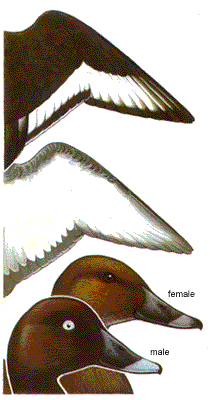
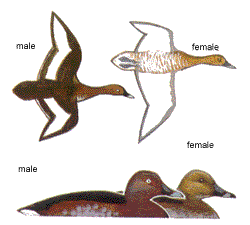
Video footage
Video footage of the Hardhead can be seen here: Hardhead
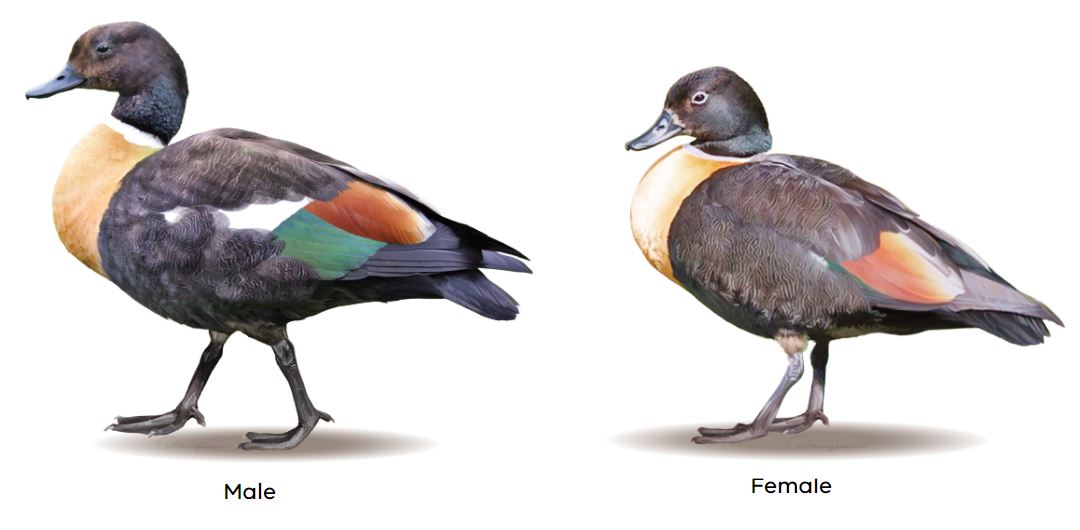 Appearance
Appearance
The Mountain Duck is the largest Australian duck. Its dark body contrasts with brilliant white wing patches.
In flight, the Mountain Duck has large, prominent white wing patches on the shoulders of the wing, a dark body, white underwings, chestnut-coloured breast and a white neck ring.
On the water or land, a large duck with a dark head, white neck ring, yellow-brown or chestnut-coloured breast.
The female and young birds have a white ring around the eye and a white face patch.
Habitat and distribution
Mountain Duck are distributed throughout south-eastern and south-western Australia and inhabit lowland wetlands, both freshwater and saline, which are near pastures or arable land. Being grazers, they feed in pastures, cultivated crops and shallow water.
For more detailed information and video click: https://www.youtube.com/watch?v=fJ1wW7XtVXQ
Distribution and habitat

Mountain Duck are distributed throughout south-eastern and south-western Australia and inhabit lowland wetlands, both freshwater and saline, which are near pastures or arable land. Being grazers, they feed in pastures, cultivated crops and shallow water.
Status
The Mountain Duck is available for recreational hunting in Victoria, Tasmania and South Australia.
Description
The Mountain Duck is the largest Australian duck. Its dark body contrasts with brilliant white wing patches.
In flight, the Mountain Duck has large, prominent white wing patches on the shoulders of the wing, a dark body, white underwings, chestnut-coloured breast and a white neck ring.
On the water or land, a large duck with a dark head, white neck ring, yellow-brown or chestnut-coloured breast.
The female and young birds have a white ring around the eye and a white face patch.
Voice
The Mountain Duck is a very vocal bird, especially in flight. The male has a low-pitched honk and the female has a high-pitched honk.
Images
Here are some images of the Mountain Duck.
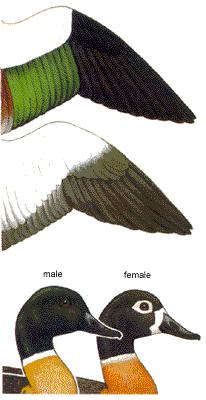
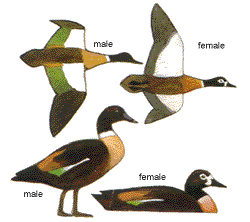
Video footage
Video footage of the Mountain Duck can be found here: Mountain Duck (Australian Shelduck)
In flight, the head is held high with the heavy bill angled downward. The species has a light underbody, white trailing edges on upperwing and tail and a white crescent on the rump. The wings are rounded.
On the water, a small, light-coloured duck floating high with zebra stripes on body, a large bill and distinctive forehead. The male and female have a similar appearance.
Habitat and distribution
The Pink-eared Duck is widely distributed throughout inland south-eastern Australia and south-western Australia, however, vagrants occur elsewhere. The Pink-eared Duck prefers shallow, temporary waters, however, extensive open wetlands support large flocks at times.
For more detailed information and video click: https://www.youtube.com/watch?v=oh7U6M9gtgg
Distribution and habitat

The Pink-eared Duck is widely distributed throughout inland south-eastern Australia and south-western Australia, however, vagrants occur elsewhere. The Pink-eared Duck prefers shallow, temporary waters, however, extensive open wetlands support large flocks at times.
Status
The Pink-eared Duck is available for recreational hunting in Victoria, South Australia and the Northern Territory.
Description
In flight, the head is held high with the heavy bill angled downward. The species has a light underbody, white trailing edges on upperwing and tail and a white crescent on the rump. The wings are rounded.
On the water, a small, light-coloured duck floating high with zebra stripes on body, a large bill and distinctive forehead.
The male and female have a similar appearance.
Voice
Chirrup uttered in flight.
Images
Here are some images of the Pink-eared Duck.
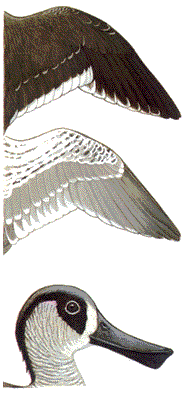
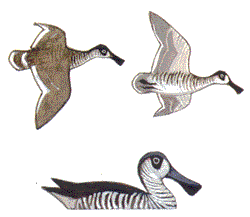
Video footage
Video footage of the Pink-eared Duck can be found here: Pink-eared Duck
The male and female look similar
The Black Duck is a major game species in Victoria and is a large duck. It is a dark-brown bird with a pale face and throat. It has a distinctive black eye-stripe that stretches from the top of the bill through the eye. The male and female have a similar appearance.
In flight, the Black Duck is a dark bird with swift wing beats and a slender neck. The upperwing has no white but does have a green, glossy colour patch on it. The underwing is white.
Habitat and distribution
The Black Duck is common and widely distributed throughout Australia and across a wide range of habitats, from deep, permanent, reed-dominated freshwater wetlands to rivers, creeks and brackish or saline wetlands.
For more detailed information and video click: https://www.youtube.com/watch?v=QfMfdkRTPAU
Distribution and habitat

The Black Duck is a major game species which is common and widely distributed throughout Australia. The Black Duck occurs across a wide range of habitats from deep, permanent, reed-dominated freshwater wetlands to rivers, creeks and brackish or saline wetlands.
Status
The Black Duck is available for recreational hunting in Victoria, South Australia, Tasmania, Queensland and the Northern Territory.
Description
The Black Duck is a dark-brown bird with a pale face and throat. It has a distinctive black eye-stripe that stretches from the top of the bill through the eye. The male and female have a similar appearance.
In flight, the Black Duck is a dark bird with swift wing beats and a slender neck. The upperwing has no white but does have a green glossy colour patch on it. The underwing is white.
On the water, the Black Duck is a medium-sized duck with a slender head and neck which is carried erect.
Voice
The female makes a loud raucous quack repeated four to six times.
Images
Here are some images of the Black Duck.
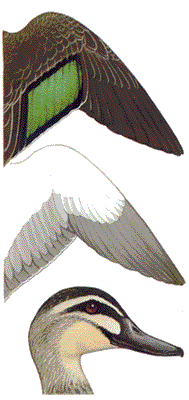
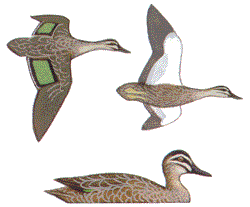
Video footage
Video footage of the Black Duck can be found here:
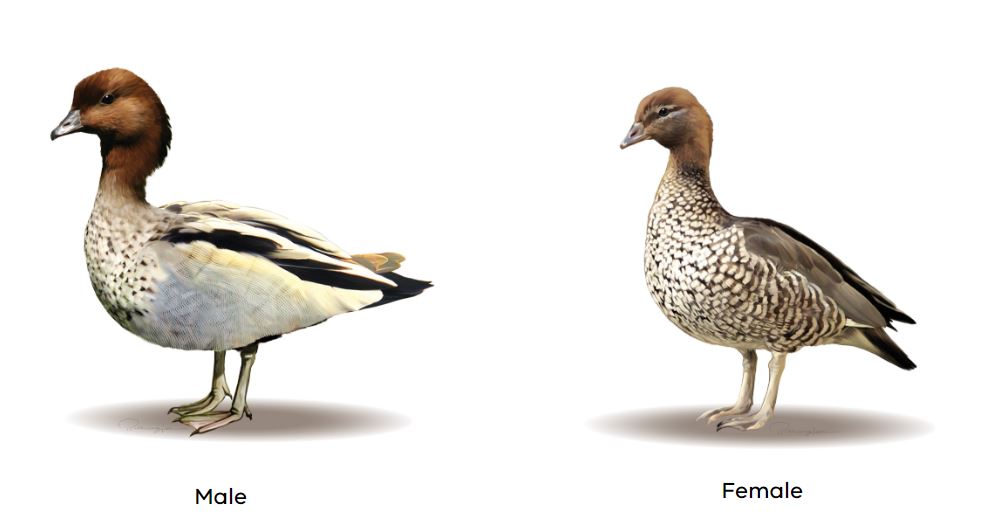 Appearance
Appearance
The Wood Duck is a medium-sized goose-like duck with long legs, extended neck, short head and is related to the pygmy-geese of tropical Australia.
In flight, the Wood Duck has slow wing beats, large white patches on the rear of the upperwing near the body and a white triangle on the upperwing near the body. The male has a black undertail and belly while the female has a white belly and dark eyestripes.
On the water or on land, the Wood Duck is a medium-sized, light-coloured duck with a dark head, a characteristic high-tailed posture on water and erect posture on land.
Habitat and distribution
The Wood Duck is widely distributed and is common throughout Australia. However, it is rare and considered to be a vagrant in tropical Australia. Wood Duck prefer lightly timbered country near water, be it swamps, dams, rivers or other waterways, where there is short grass or herbage beneath the trees. It is seldom found in dense or extensive swamps and avoids brackish or saline water.
For more detailed information and video click: https://www.youtube.com/watch?v=wLiMsrwonFg
Distribution and habitat

The Wood Duck is widely distributed and is common throughout Australia. However, it is rare and considered to be a vagrant in tropical Australia. The Wood Duck prefers lightly timbered country near water, be it swamps, dams, rivers or other waterways, where there is short grass or herbage beneath the trees. It is seldom found in dense or extensive swamps and avoids brackish or saline water.
Status
The Wood Duck is available for recreational hunting in Victoria, South Australia, Tasmania and the Northern Territory.
Description
The Wood Duck is a medium-sized goose-like duck with long legs, extended neck, short head and is related to the pygmy-geese of tropical Australia.
In flight, the Wood Duck has slow wing beats, large white patches on the rear of the upperwing near the body and a white triangle on the upperwing near the body. The male has a black undertail and belly while the female has a white belly and eyestripes.
On the water or on land, the Wood Duck is a medium-sized, light-coloured duck with a dark head, a characteristic high-tailed posture on water and erect posture on land.
Voice
Drawn-out nasal mew. Shorter and higher pitched in the male than the female.
Images
Here are some images of the Wood Duck.
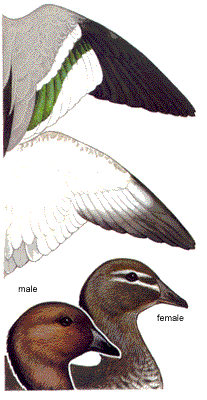
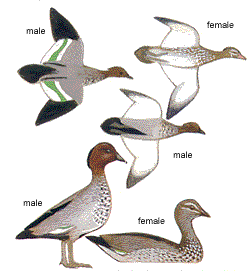
Video footage
Video footage of the Wood Duck can be found here: Wood Duck (Maned Duck)
To be declared game, species are generally common and occur in large numbers. However, just because a species is considered game in one state does not mean it is game in another.
The status of game species may change from time to time and hunters should always check current regulations, season dates and bag limits. Some game species may be protected from hunting at particular times, such as during drought, or bag limits may be changed in response to population numbers and/or environmental conditions.
Prior to applying for Game Licence to hunt game ducks in Victoria hunters need to pass the Waterfowl Identitification Test.
All species of Australian waterfowl are readily identifiable, especially within shotgun range.
Most of our written descriptions of game waterfowl and other common waterbirds are accompanied by illustrations. The illustrations are intended to highlight important distinguishing features and allow for positive identification of the bird, both in flight and in the hand. Important distinctive field marks that allow you to differentiate between each of the species is shown in bold type. The distribution of light and dark plumage is particularly important when identifying waterfowl, especially the presence and position of white areas on the wings and the contrast between underwing, neck and body. Some species have distinctive shapes and voices.
Size may also be helpful in distinguishing between species. For example, the Mountain Duck is a large duck, the Black Duck is a medium-size duck and the Grey Teal is a small duck. This image shows the relative sizes of common waterbirds which are likely to be encountered while hunting.
A distribution map is also included with most descriptions and shows the usual range of each of the species. However, most Australian waterfowl are nomadic and may be found as vagrants outside their usual range. It is important to learn how to identify those waterfowl you are most likely to encounter in the region in which you hunt.

